C07 Henslin9e
- 1. This multimedia product and its contents are protected under copyright law. The following are prohibited by law: any public performance or display, including transmission of any image over a network; preparation of any derivative work, including the extraction, in whole or in part, of any images; any rental, lease, or lending of the program. A Down-to-Earth Approach 9/e SOCIOLOGY SOCIOLOGY Chapter 7: Bureaucracy and Formal Organizations
- 2. “ The idea that efficiency and practical results should dominate human affairs.” Copyright © Allyn & Bacon 2008 The Rationalization of Society
- 3. Prior - Traditional Orientation Past Best Guide for Present Protect Status Quo Bases on Personal Relationships Copyright © Allyn & Bacon 2008 Why Did Society Change?
- 4. Post - Industrialization- Capitalism Rationality - Most Efficient Going Forward Attention to Bottom Line Copyright © Allyn & Bacon 2008 Why Did Society Change?
- 5. Copyright © Allyn & Bacon 2008
- 6. Copyright © Allyn & Bacon 2008
- 7. Copyright © Allyn & Bacon 2008
- 8. Marx: Capitalism Broke Tradition Weber: Religion Broke Tradition The Two Views Today Copyright © Allyn & Bacon 2008 Why Did Society Change?
- 9. “ Secondary groups designed to achieve explicit objectives.” Copyright © Allyn & Bacon 2008 What Are Formal Organizations?
- 10. Characteristics of Bureaucracies Clear Levels Division of Labor Written Rules Written Communication and Records Impersonality & Replaceability Copyright © Allyn & Bacon 2008 Formal Organizations and Bureaucracy
- 11. Copyright © Allyn & Bacon 2008
- 12. “ Ideal” vs. “Real” Bureaucracy Extent of Bureaucracy - A Matter of Degree Ideal vs. Actual Organizational Chart Copyright © Allyn & Bacon 2008 Formal Organizations and Bureaucracy
- 13. Red Tape - A Rule is a Rule Lack of Communication Between Units Bureaucratic Alienation Copyright © Allyn & Bacon 2008 Dysfunctions of Bureaucracies
- 14. Resisting Alienation The Alienated Bureaucrat Bureaucratic Incompetence Copyright © Allyn & Bacon 2008 Dysfunctions of Bureaucracies
- 15. Goal Displacement Perpetuation of Bureaucracies Social Significance of Bureaucracies Copyright © Allyn & Bacon 2008 Bureaucracies
- 16. Functions of Voluntary Associations Advance Particular Interests Offer People Identity Govern Nations and Maintain Social Order These Apply to All or Most Voluntary Associations Copyright © Allyn & Bacon 2008 Voluntary Associations
- 17. Functions of Voluntary Associations Mediate Between Government and Individuals Help Individuals Climb Occupational Ladder Bring People into Political Mainstream Pave Way for Social Change These Apply to Only Some Voluntary Associations Copyright © Allyn & Bacon 2008 Voluntary Associations
- 18. Shared Interests Motivations for Joining Differ Experience High Turnover The Problem of Oligarchy Leaders Grow Distant from Members Iron Law of Oligarchy Copyright © Allyn & Bacon 2008 Voluntary Associations
- 19. Self-Fulfilling Stereotypes and Promotions Stereotypes and the Iron Law of Oligarchy Copyright © Allyn & Bacon 2008 Working for the Corporation
- 20. Develop Rather than Impede Potential Access to Opportunities Distribute Power More Evenly Can Bureaucracies Adapt? What is the Cost of Change? Copyright © Allyn & Bacon 2008 Humanizing the Corporate Culture
- 21. Work Teams Corporate Day Care Employee Stock Ownership The Conflict Perspective Fads in the Workplace Copyright © Allyn & Bacon 2008 Humanizing the Corporate Culture
- 22. The Rise of the Microchip Surveillance in the Workplace Monitoring Computer Use Copyright © Allyn & Bacon 2008 Technology and the Control of Workers
- 23. How They Differ Hiring and Promoting Teams Lifetime Security Almost Total Involvement Broad Training Decision-Making by Consensus Copyright © Allyn & Bacon 2008 U.S. and Japanese Corporations
- 24. Myth vs. Reality Most Don’t Find Lifelong Job Security Management by Consensus False Copyright © Allyn & Bacon 2008 U.S. and Japanese Corporations
- 25. A Down-to-Earth Approach 9/e SOCIOLOGY SOCIOLOGY Chapter 7: Bureaucracy and Formal Organizations
























